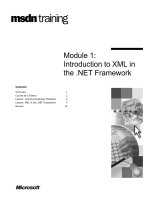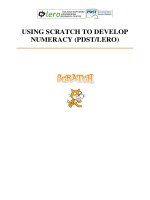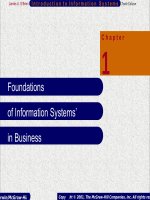Slide INTRODUCTION TO RESEARCH IN APPLIED LINGUISTICS
Bạn đang xem bản rút gọn của tài liệu. Xem và tải ngay bản đầy đủ của tài liệu tại đây (1.93 MB, 77 trang )
RESEARCH METHODS IN APPLIED LINGUISTICS (ENG6005)
Lecture 1
INTRODUCTION TO RESEARCH IN APPLIED LINGUISTICS
Supervisor: Ms.Nguyễn Thị Minh Huệ
Group 3A: Đỗ Thị Hồng Diệp (k18A)
Lê Ngọc Hân (k18A)
Trần Thị Thu Hiền (k18A)
Nguyễn Thị Hồng Minh (k18B)
OUTLINE
1. Definitions and aims of a research
2.Social science and social reality-the truth
3.A model of research process
4. Terms in applied linguistics research
5. Reference
6.Conclusion
What is research?
1. Definitions and aims of a
research
1.1.Definitions:
1
Research is
the process of
going up
alleys to see if
they are blind
(Marston
Bates,
American
writer)
2
Research is
what I am
doing when I
don’t know
what I am
doing
(Von Braun,
American
engineer)
3
If you steal
from one
author, it’s
plagiarism; if
you steal from
many, it’s
research.
(Wilson
Mizner,
American
dramatist)
1. Definitions and aims of a
research
1.1.Definitions:
Research is a detailed study of a
subject, especially in order to discover
(new) information or reach a (new)
understanding.
(Cambridge Dictionaries
Online )
Research is about asking and beginning
to answer questions, seeking
knowledge and understanding of the
world and its processes.
(Wisker,The
Postgraduate Hanbook, 2001, p.114)
Research is systematic and controlled.
Research is empirical and research is
self-correcting.
(Cohen, Research
Methods in Education, 2007, p.7)
1. Definitions and aims of a
research
Research is a systematic process of inquiry consisting of three
1.1.Definitions:
elements or components:
a question, problem, or hypothesis,
data.
analysis and interpretation of data.
(Nunan, Research Methods in Language
Learning,1992, p. 3)
1. Definitions and aims of a
research
1.2. Aims
Solve
problems,
verify the
application
of theories,
and lead on
to new
insights.
get a result
with
scientific
methods
objectively,
not
subjectively.
Prove/disprove
new or existing
ideas to
characterize
phenomena and
to achieve
personal and
community
aims.
Enlighten
both
researcher
and any
interested
readers.
1. Definitions and aims of a research
1.2. Aims
Prove/disprove,
demystify, carry out
what is planned, to
support the point of
view, to uncover what is
not known, satisfy
inquiry.
Discover the
cause of a
problem and
find the
solution to a
problem
Gather and analyze a
body of information
or data and extract
new meaning from it
or develope unique
solutions to problems
or cases.
Report or review, not designed
to create new information or
insight but to collate and
synthesize existing
1. Definitions and aims of a
research
Title
: Using
1.3.An dictation
analysis
of a model
to improve
Language Proficiency
research
Source: 2008
Journal, Volume 10,
issue 1, March
2008, www.asianefl-journal.com
Author :
Mohammad
Rahimi
Shiraz
University
www.themegallery.com
Company Logo
The model research
What are objectives ?
How are these objectives achieved?
1. Definitions and aims of a research
1.3.An analysis of a model research
1.3.1.Objectives:
To investigate
the effect of
dictation on an
experimental
group (EG) and
a control group
(CG) and show
that the EG
improved in
grammar,
vocabulary
and, reading
and listening
skills while the
CG just
enhance
vocabulary.
To survey on 65
English majors
enrolled in
Conversation II
classes, in
particular their
attitudes and
behaviors
towards using
dictation to
improve
Language
Proficiency
To prove that
dictation was a
technique
which could be
used both as a
testing
technique and
more
importantly , as
a learning
activity which
helped students
develop their
accuracy in
listening and
writing skills
and reinforced
structure and
vocabulary
To deal with the
problem of the
short time length
between practicing
with dictation and
the post test given
the to the students
to investigate the
effect of dictation
on the
improvement of
learners’
proficiency.
1. Definitions and aims of a research
1.3.An analysis of a model research
1.3.2.How these objectives are achieved:
The results and the
conclusion
Literature review
The research
questions
The study
How
The process of data
collection and
analysis
The research instruments
2. Social science and social reality-the truth
2.1. Different views
Social reality
Social science
2. Social science and social reality-the truth
2.1. Different views:
Social science
Why are these concerned?
Social reality
-The truth
Research
is a
combination
of both
experience and
Reasoning
(Borg 1963)
Research
must
be
regarded
as the most
successful
approach to the
discovery of
the truth
(Borg 1963)
2. Social science and social reality-the truth
2.1. Different views
Social science
Traditional view
(established view)
Interpretive view
Social science
Traditional view
are the same as the
natural sciences, should
discover natural and
universal laws
regulating and
determining individual
and social behaviours.
Interpretive view
While sharing the rigour
of the natural sciences
and the concern to
describe and explain
human behaviours,
emphasies the difference
of people from inanimate
natural phenomena and
from each other.
Social reality-the truth
Ontological
assumptions
Espistemological Human
assumptions
assumptions
methodological
assumptions
Based on the work of Burell and Morgan (1979)
Social reality-the truth
The nature
or essence
of the
social
phenomen
a
Ontological
Being
assumptions
investigate
d
- is social reality external
to individuals (objective
nature)
- Social reality is the
product of individual
consciousness (results
of personal recognition)
The very
bases of
knowledge:
its nature
and forms
Espistemological
assumptions
- Knowledge is hard, objective
and tangible: researcher is
observer – natural methods,
positivsm
-Knowledge is personal,
subjective and unique:
researcher- participant
observer, rejection of natural
science methods, antipositivism.
2. Social science and social reality-the
truth
2.2. Examples from a real research:
A model research
Title : Using dictation to improve Language Proficiency
Author : Mohammad Rahimi , Shiraz University.
Source: 2008 Journal, Volume 10, issue 1, March 2008,
www.asian-efl-journal.com
2. Social science and social reality-the truth
2.2. Examples from a real research:
Traditional view
-The causal relationship between
dictation and language proficiency
+”Dictation -a testing
device for measuring
language proficiency”
+“dictation
helps learners improve
Different aspects of their
proficiency”
-”dictation-a teaching technique
of language proficiency”
Interpretive view
-Different views
+Lado (1961) considers dictation
as having very little value in
testing the language
+ Harris (1965), rejects dictation as
an “uneconomical” and “imprecise”
technique
of language testing
+Stanfield (1985) rejects using
dictation as a test of
foreign language proficiency due to
its strong association with
the Grammar Translation Method.
+Cartledge (1968) believes that
Dictation is not a teaching device
2.The nature of social sciences and social
reality
2.1. Examples from a real research
Ontological assumptions
Espistemological assumptions
-The products of different
writers' views:
+Stanfield (1985) mentions
that since in dictation the learner
employs more than one faculty,
he is more successful in
internalizing the language.
+Pappas (1977) considers
dictation as a good means
of developing learners’ listening
comprehension.
+Oller and Streiff (1975) believe
that as dictation triggers the
internalized expectancy grammar
of the learner, it can give us
information about his overall
language proficiency.
-The results of science methods:
+The results of the study, to some
extent, support those of Valette
(1964) and Morris (1983), since
they claimed that practice with
dictation helps learners improve
their language proficiency
+The results of the present study
lend support to the above hypothesis
which implies that a teaching
technique may show its effects
in the long run.
Involves:
3.A model of research process
3.1.Definition of research
process
Formulating an
hypothesis
defining problem
Stating an
objective
3.A model of research process
3.2.Two phrases of research process:
formulating the
question
- identify a research
problem, narrow the
topic, and state
hypotheses of
expected outcome.
seeking the
answer
- collect data,
analyze findings,
interpret
evidence,
summarize and
draw significant
conclusions.
3.A model of research process
3.3. The basic process of research
:
1 Problem/ Experience/Observation
2
3
Hypothesis
Investigation and experimentation to
test the hypothesis
4
Data collection
5
Data analysis and interpretation
6
Confirmation or disapproval of the
hypothesis
3.A model of research process
3.3. The basic process of research
:
1
Problem/ Experience/Observation
-Identify information problem
-Demonstrate an
understanding of
how information is
organized and
located.
-Decide how much
- information is needed









